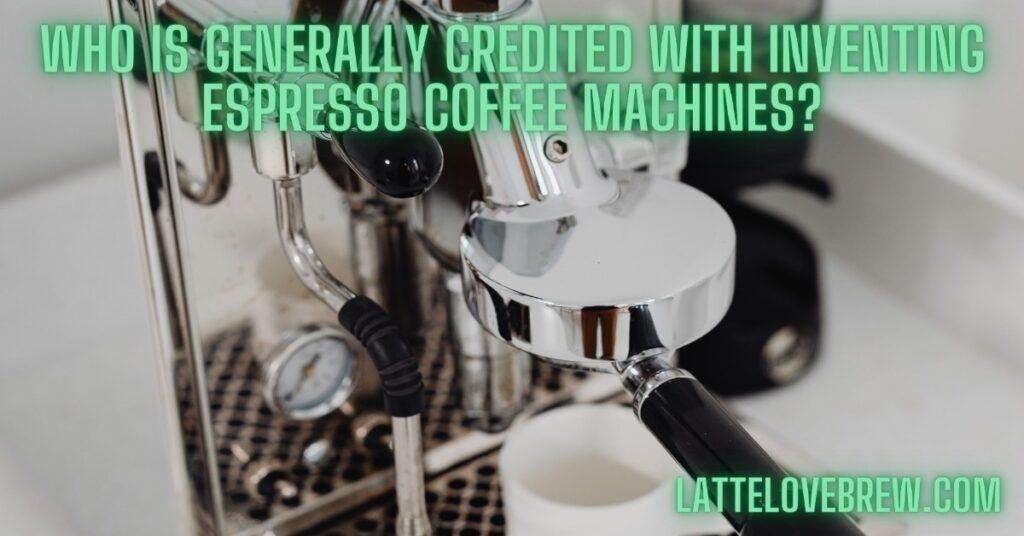Last updated on October 27th, 2023 at 15:18
In the coffee-loving culture of Vietnam, at a pub quiz the question “Who Is Generally Credited With Inventing Espresso Coffee Machines?” was a question posed by the quiz master in a do-or-die win or bust tiebreaker.
In my best Italian accent, mimicking the famous way they all speak, “Angelo Moriondo” I exclaimed, continuing “Angel Moriondo, of Turin, Italy, in the year 1884!”
“Luigi Bezzerra and Desiderio Pavoni” Replied the Quiz master, in a dead pan manner!
A debate ensued.
Hey, we are serious about our pub quiz as I am about my knowledge of coffee. I knew the correct answer and the story of Bezzerra and Pavoni of Milan answer. Their patent was granted in 1902, almost 2 whole decades after Angelo Moriondo.
A quick check and search of Google Patents and the prize was won. Better than winning the quiz was the “how the…” look on their faces confused as to how I knew the answer and corrected the quiz master!
(coffee geeks rock!).
In the remainder of this article I will detail who invented The Espresso Coffee, the meaning of the drink and size and details about when it was first introduced and more details about the man, the legend, Luigi Bezzera, the OG of coffee geeks and coffee lovers, who invented the first commercially available espresso machine, but not the Original.
Keep reading to find out the true story of the Espresso Machines invention and who really invented it first!
Let’s start at the very beginning, shall we?
What Is An Espresso? — Espresso Coffee Meaning!
Table Of Contents
- 1 What Is An Espresso? — Espresso Coffee Meaning!
- 2 Who Invented The Espresso Coffee? The History Of Espresso Machines
- 3 When Was the First Espresso Machine Introduced?
- 4 Who Is Luigi Bezzera?
- 5 Frequently Asked Questions About Who Is Generally Credited With Inventing Espresso Coffee Machines
- 5.1 Who Made The First Espresso Machine?
- 5.2 When Was The Espresso Coffee Machine Invented?
- 5.3 Is Espresso Italian Or Spanish?
- 5.4 How Was Espresso Originally Made?
- 5.5 What Was The First Brand Of Coffee?
- 5.6 Who Invented Espresso Machines?
- 5.7 Which Country Invented Espresso Coffee?
- 5.8 Is Espresso From Italy Or France?
- 6 Frappé-ing It All Up – Who Is Generally Credited With Inventing Espresso Coffee Machines?
An espresso is a method of brewing a short, concentrated coffee of Italian origin using a very finely ground espresso roasted coffee beans.
The method of elaboration requires the use of a small amount of water that is almost boiling, typically 190F (90C) and under high pressure of 9 to 10 bar. It is by far the most popular brewing method in continental Europe, particularly Spain, Portugal, Switzerland, France and, of course, Italy.
The resulting espresso, due to the brewing process, is slightly and notably thicker than alternative brewing techniques. The greater viscosity is due to a greater amount of dissolved and suspended solids and the famed rich crema on top.
An authentic espresso shot forms the base of many coffee drinks, including cappuccino, latte, caffe Americano, Mocha, macchiato and more.
An espresso does not have more caffeine than other brewing mechanisms and processes. However, the amount of caffeine per fluid ounce of coffee is higher.
The meaning of “espresso” is from the high pressure technique and the brew time is rather quick and made in typically 25 to 30 seconds. The word espresso is in reference to forcing pressurized steam or hot water.
It is closely linguistically related to “Express”, the English word that shares the meaning.
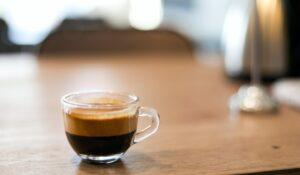
Read: Best cappuccino flavors
Espresso Shot Ml – How Many Ml Is In A Shot Of Espresso?
An original shot of espresso was 25 ml in quantity and multiples there of with a double espresso being 50 ml.
However,
a modern espresso has grown to be on average 30ml and multiples of that.
In imperial countries such as the United States the standard size is one ounce, which is 29.57ml — which is where the enlargement of a traditional espresso is attributed.
A standard espresso has 7 to 9 grams of very finely ground espresso grounds per shot at a 1.5:1 or 2:1 water to espresso ratio with the exemption being a ristretto, which is a 1:1 coffee to water ratio.
Who Invented The Espresso Coffee? The History Of Espresso Machines
A quick Google search for the term “Who Invented The Espresso Coffee?” and you will, currently see in position zero “businessman Luigi Bezzera” in large bold writing as being accredited to inventing the most famous cup of coffee in history.
At Latte Love Brew, we believe in accuracy and facts. Facts matter. They do not change, period!
Facts are facts! Find out at the end how and what you can do to make facts matter!
It is not only Esquire coffee who have not done their proper research and homework and thus have questionable knowledge on the subject of coffee as a subsequence of what is a very basic schoolboy error.
Other sites, such as coffee altura, serious eats and total espresso, make this mistake also.
The very first machine that was designed for, and made an espresso coffee, was designed, built and patented by the aforementioned Italian Angel Moriondo of Turin. He demonstrated his working prototype of the machine at the General Exposition of Turin in 1884.
Moriondo was granted Patent 33/256 on the 16th of May 1884. This is documented on pages 635 to 655 of 1884, the second series edition of the Bollettino Delle Privative Industriali Del Regno D’Italia (The Italian Industrial Property Bulletin).
He was awarded a certificate of industrial title for his invention of a, and I quote “New steam machine for the instantaneous confection of coffee beverage, ‘A. Moriondo’ Method, Plate CXL”.
His fellow Italian, Luigi Bezzera who is often miscredited with the invention, made some improvements to the design in 1901, for which a patent was applied for on the 19th of December of the same year.
The patent was granted on the 5th day of June the following year, 1902 (Patent Number 153/94, 61707 “Innovations for the machinery for the preparation and immediate serving of coffee beverage”).
Desiderio Pavoni played a very small, insignificant role in the invention of this new and improved machine.
He simply bought the patent from Luigi Bezzera, is, however, correctly accredited in the production of the first commercially available espresso machine. This was the nature of his business with the birth of La Pavoni company.
Francesco Illy, a Hungarian-Italian has is part in the gang of “espresso OG’s” as he, in 1933 invented the first automatic coffee machine which made the change of switching pressurized water for steam.
This machine is basically the base for all modern espresso machines that you see in coffee shops the world over.

When Was the First Espresso Machine Introduced?
The first machine for making espresso was built and patented in 1884 by Angelo Moriondo of Turin, Italy. While popular in Europe at the time, especially in Italy, the first Espresso machine did not arrive in the United States until 1906.
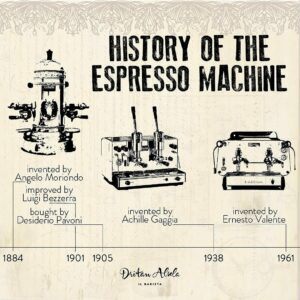
How Does A Manual Espresso Machine Work?
There are two main types of manual espresso machines. Which are as follows:
- 1. Spring Piston.
- 2. Manual Piston.
With the Manual piston design, you as the operator are directly pushing water through the layer of grounds. This type is often called a lever machine.
The Spring piston design as a barista you work to tension a spring that will then provide the necessary pressure to the roasted coffee grounds for the elaboration of the espresso shot.
In more recent times, a new method has been added to the espresso world has arrived in the form of air-driven pumps.
The brewing mechanism of air pumps uses compressed air to force the water through your grounds. The water can be added directly from a kettle or from a thermal flask.
The compression of the air is achieved in a few different ways. Namely, Carbon Dioxide or Nitrogen cartridges, a hand pump or an electric compressor.
The main and distinctive advantage of these machines is their portability due to being mostly handheld, smaller and much lighter.
This first of this type is the AeroPress, an invention by Alan Adler in 2005 which was quickly followed up with the HandPresso Wild by Nielson Innovation 2 years later.
Time will only tell if Alan Adler and Neilson become known as the new wave of modern Espresso OG’s.
Are Manual Espresso Machines Better?
Yes,
in my expert opinion and experience, a manual espresso machine produces an espresso of higher quality because you have complete control of every single variable that goes into making the shot.
A manual espresso coffee machine takes some time, practice and dedication to get it right, and more importantly, to get it right consistently.
Not all manual espresso machines are made the same way and all function in a slightly different way from each other and will require you to get used to them.
Italian Espresso Machine — What Is The Most Popular Espresso Machine In Italy?
They are literally all made in Italy or by Italian companies.
Some brands recently have relocated and shifted their manufacturing base back to their roots to Europe’s coffee and culture capital, Italy.
By far the most popular espresso machine is the DeLonghi ESAM 3300 Magnifica based on popularity, sales volume by number of units sold and rating across a number of ecommerce sites including Amazon, eBay, Walmart, Ali Express, and Lazada.
The DeLonghi 3300 Magnifica is an automatic machine that is very easy to use.
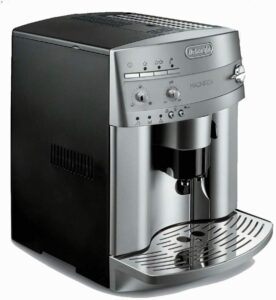
Who Is Luigi Bezzera?
Luigi Bezzera is the Milanese businessman that created the first commercially available espresso machine. The creation of this machine improved efficiency and the time taken to produce coffee.
No longer did Italians and coffee lovers the world over need to wait for a time-consuming filter coffee to be made.
The Bezzera espresso machines, much more modern versions, are still available and in manufacture today.
Are Bezzera Espresso Machines Good?
Yes, the Bezzera espresso machines are highly rated and well respected in the artisanal coffee culture world. I have spoken with and consulted with a well known and well respected coffee culture commentator and asked their opinion on Bezzera machines as a brand.
The discussion was very interesting and insightful, with confirmation that the output quality is very high and among the best of its type and able to make coffee beverages of all types using ordinary tap water.
That was quite something as this particular person is known for insisting on using mineral water or distilled water for making his caffeinated drinks.
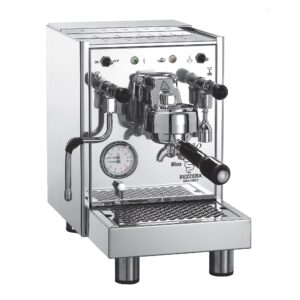
Where Are Bezzera Espresso Machines Made?
Bezzera makes their espresso machines in Rosate, which is near Milan, Italy.
The entire production is carried out there, including final inspection and export to overseas markets.
How Long Do Bezzera Machines Last?
If you take good care of your machine, regularly descale it, give it a good clean and with good maintenance, you can make it last for 10 to 12 years and even longer.
Think of it like a car, take care of it well and a car can last you an incredibly long period of time, 15, 20 and even 25+ years.
Frequently Asked Questions About Who Is Generally Credited With Inventing Espresso Coffee Machines
Who Made The First Espresso Machine?
Angel Moriondo of Turin, Italy is the very man we can credit with patenting and inventing the first espresso machine.
It is his invention that helps us to enjoy many different espresso based drinks like an espresso, ristretto, cortado, Americano, latte, mocha, macchiato, lungo a flat white and the many more that came around afterward.
When Was The Espresso Coffee Machine Invented?
The espresso coffee machine was invented in 1884 and was first displayed at the Turin General exposition. It wasn’t until much later that the machine came into popular use to brew coffee.
Is Espresso Italian Or Spanish?
An espresso originates in Italy, even the word comes from the Italian language, which translates to “Express” meaning fast due to the short brewing time of the beverage.
How Was Espresso Originally Made?
The first espresso machines worked by forcing steam through a bed of coffee, which due to the high temperature produced a burnt and overtly bitter taste.
The ideal brewing temperature for coffee is 92C to 96C (195F to 205F). The subtle difference in temperature of boiling hot steam does result in over extraction and a strong and bitter taste.
The piston pump which corrected this problem was later developed as was temperature control which prevented the water from reaching too high a temperature.
What Was The First Brand Of Coffee?
The earliest brand of coffee known was Arbuckle Ariosa by John Arbuckle of New York. They mass-produced their coffee and sold it all over America. They might not be the very first, but are the first mass-produced brand of coffee.
Who Invented Espresso Machines?
Angelo Moriondo invented the espresso machine in 1884.
Which Country Invented Espresso Coffee?
Espresso was invented in Italy by the Italian Angelo Moriondo. More specifically, it was invented in Milan.
Is Espresso From Italy Or France?
Espresso is from Italy. The world comes from express, the fast train. The coffee is exactly that originally the machines, like the trains of the day, were steam powered and produced a coffee in a matter of seconds, hence the name espresso.
Frappé-ing It All Up – Who Is Generally Credited With Inventing Espresso Coffee Machines?
The deal is done, the dust is settled and the facts have been proven beyond all reasonable doubt and the question “Who Is Generally Credited With Inventing Espresso Coffee Machines?” has been answered accurately, and more importantly, factually.
Italian Angelo Moriondo Of Turin is the Espresso Machine OG having invented it in 1884. It is thanks to this gentleman that we have specialty coffee and not stuck using peculators, stovetop moka pots, drip coffee or the favorite in Italy at the time, Turkish Coffee.
…or forever making cappuccinos with whipped cream.
If facts matter to you, please like, share and comment on this post on social media and help poor google to correct the error that they are currently displaying in position zero of the search results.
If you love coffee, and making great coffee matters to you, join our online coffee community on Facebook/Meta and share your coffee creations, ideas and images with us all.
We’d love to hear from you!

